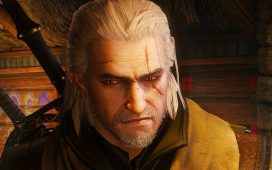A reader allows the Shenmue I & II remakes to take him back to his childhood and realise just how reflective the games are of real life.
It took me over five months, but in April of this year I finally finished the main story in Red Dead Redemption II. It was a game I became lost in so often, admiring the little touches, the weather, how the locals of towns would react around you and what could be found by rummaging through the drawers of people’s homes.
While open world titles are not in short supply, there have been very few with the attention to detail of Red Dead Redemption II. Such intricacy in a game world has always made a setting feel more immersive to me, and along with The Elder Scrolls series only one other has provided me with that level of connection.
That other series is Shenmue. Yes, in scope, it’s far smaller than most modern open worlds. But what it lacks in size it more than makes up for it in how intimate the setting is. There’s a reason why super fans of the franchise go on pilgrimages to Yokosuka.
When Shenmue first launched nearly 20 years ago there was nothing else quite like it, and even now the meticulous detail, from character routines to the ability to pick up all the random paraphernalia in the Hazuki home, is impressive. Want to see what’s in Ryo’s fridge? Go ahead, open it up, have a root around and maybe take out a bottle of milk to give to that kitten down the road.
With the third entry on the horizon and Red Dead Redemption II done and dusted, the Xbox One version of Shenmue I & II was next on my playlist. On booting up the first game I was immediately hit by a wave of nostalgia; the music, the setting, the voice acting – this was the feeling of both playing a game and revisiting a long-lost place from my younger years. It was beautiful.
Now, knowing the game as well as I do, I went about maximising the experience. There were, of course, numerous scenes and interactions that only appear in certain circumstances, but most of my time was spent in the arcade playing games and, more importantly, collecting the gachapon toys.
I made collecting gachas my number one priority after the story. There were several reasons for this: collecting them was tied to an Achievement; duplicates could be sold in Shenmue II solving the headache that a lack of money presents in that game; and finally it’s simply fun to collect the cutesy Sega memorabilia. The problem was Ine-san’s allowance would only go so far and constantly ploughing 100 yen coins into the capsule and vending machines in the vain hope of winning a rare toy was an expensive habit.
It’s widely known that Shenmue does feature a certain level of waiting around, and in those quiet moments the game became very much a parallel of many a childhood frustration: all this free time but not enough money to make the most of it. But I didn’t fear, whiling away my penniless hours with Ryo’s Sega Saturn and recently won copy of Space Harrier in the Hazuki rec room, I knew a source of income was just around the corner.
I don’t think I could ever sufficiently explain how happy this makes me.
Night all! pic.twitter.com/gaG4x0QGvI
— Dan Driver (@swooper_d) April 28, 2019
I was ecstatic to start Ryo’s job as a forklift driver. It’s taken in story to get closer to the gang working in the harbour; the menial job revolves around nothing more than moving crates from one location to another, with a warmup race hosted by your boss every morning. It’s a cushy 9 to 5 job with a generous two-hour lunch break and a free meal. You are set a daily quota to meet every day and your success results in a 50 yen raise per crate moved.
Naturally, this appeals to the ambitious, the enterprising, and anyone with a hint of obsessive-compulsive behaviour. The money was the key driver for me, more money for gachas after all. But I also wanted to ensure I cleared every crate available, leaving none to spare, whilst stacking them neatly within the lines – my OCD coming into force in that respect.
All of this meant I treated the job with relative seriousness, rushing between warehouses as if I was on a time trial, shouting in frustration whenever a cat or the harbour’s local jogger got in the way. For Ryo this was a real job and whatever his motivations for taking it, getting praise from the grizzly old foreman always felt rewarding.
But it was at the end of the very first day of work that I realised that the job and the influx of cash wasn’t entirely positive. At 5pm, after receiving a few thousand yen for my hard work, I realised how pressed for time Ryo and I were. I wanted to rinse the capsule machines with Ryo’s newfound affluence badly, but my presence at the harbour had attracted attention and the storyline became my main objective.
It was only once the events of the night were done with, whether it was a motorbike race, a training session with the harbour’s homeless resident or a brawl with the Mad Angels, that I was able to do as I pleased. However, with just a few hours remaining in-game before Ryo had to return home, there really wasn’t much time to do anything.
And so it continued, the inverse of the earlier problem I had in the game. Earlier in Ryo’s journey he had time but not enough money, now he had money and no time.
Perhaps I didn’t realise this predicament in my previous playthroughs on Dreamcast because I played it when I was younger, was focussed solely on finishing the game and had far less by the way of personal responsibilities to worry about. But now the change in Ryo’s priorities in the wake of his new job were far too familiar and poignant.
Ryo’s job was as consuming for him as my own, even down to the daily commute taking time out of his morning and evenings. The time for enjoying arcade and capsule machines was reduced to tiny windows, much like my own time gaming – there’s a reason why it took so long for me to finish Red Dead Redemption II.
And Ryo’s other priorities, in advancing the plot and meeting friends, were important tasks that needed to be done – a parallel of the numerous tasks adults must complete when our day jobs are done, before we can enjoy ourselves. Sure, hunting your father’s killers is far more interesting than doing the ironing or making the kids’ packed lunches, but in both cases they are things that you need to do before you can do what you want to do.
They say art imitates life, and despite the abundance of progress in the open world genre I still believe that Shenmue is unrivalled in holding up a mirror to gamers, transporting them to another world that feels tangible and real. That the game still has an ability to surprise and make me feel new things nearly 20 years on is a testament to its quality and Yu Suzuki’s vision.
It’s fitting that Ryo, so rash and impulsive in the series, gets his first taste of adulthood through his forklift job. It’s not long after that he goes it alone, breaking from the relative comfort of his family home, his friends and the doting Ine-san in venturing to Hong Kong and the unknown, where earning a living becomes even more important given Ryo must pay for his own lodgings.
Now more than ever I can appreciate Ryo’s growth as a character, beginning with what amounts to a mini-game. And as a result I’m even more excited to see where the third entry will take us.
By reader Daniel Driver
Swooper D – gamertag/NN ID)
swooper_d – PSN ID/Steam ID/Twitter
The reader’s feature does not necessary represent the views of GameCentral or Metro.
You can submit your own 500 to 600-word reader feature at any time, which if used will be published in the next appropriate weekend slot. As always, email gamecentral@ukmetro.co.uk and follow us on Twitter.














